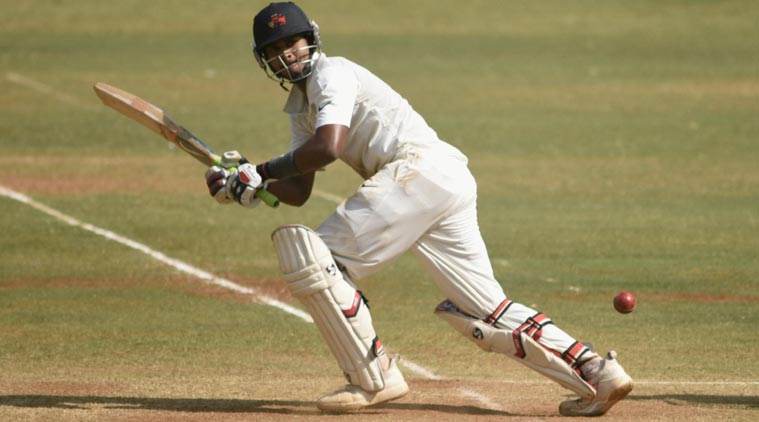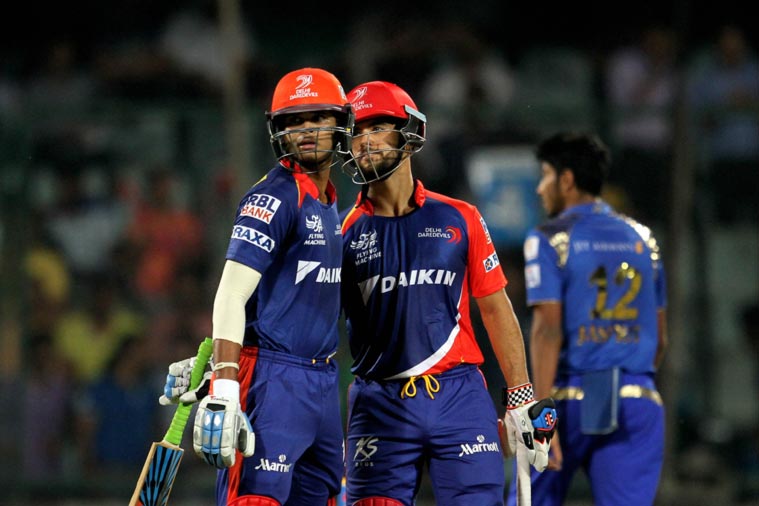The monk who cruises in his Ferrari
 Despite falling short of VVS record, Shreyas Iyer ended the season with an average of 73.38. (Source: File)
Despite falling short of VVS record, Shreyas Iyer ended the season with an average of 73.38. (Source: File)
MR IYER: Shreyas loves playing pranks on his mother. He would often call up from England in a changed accent and try to fool you no?
MRS IYER: Arey, tu hi ek dum fass gaya tha one time.
MR IYER: Yeah. I got a call from someone saying “I’ve heard you’re coming here to Nottingham to see your son,” and I proudly replied, “Yes sir, I’m planning to come.” Then I hear Shreyas go, “Papa it’s me.”
MRS IYER: Ha ha. See you’re the one who falls for it always.
Santosh and Rohini Iyer — who is Manglorean — are a jovial couple, who throughout the conversation keep ragging each other and the reason they even bring up his penchant for pranking is to play down their son’s reputation as being a shy, reserved 21-year-old who quite literally does all the talking, as the cliché goes, with this bat in this season.
 The Iyer family at their Worli residence in Mumbai. (Source: Express Photo by Ganesh Shirsekar)
The Iyer family at their Worli residence in Mumbai. (Source: Express Photo by Ganesh Shirsekar)
He has piled up 1,321 runs, just 95 short of VVS Laxman’s record for most runs in a Ranji season, a stupendous achievement for someone so young. A match-winning century in the final seemed like an inevitable culmination of a watershed season, where he’s gone past 50 in 11 out of 19 innings.
More than the runs itself, it’s been his audacity at the crease that has won him admirers. His strike-rate in the Ranji Trophy was an eyebrow-rousing 92.70. The 142-ball 117 in the Ranji final in Pune was Shreyas’ sixth first-class ton and the slowest — with a strike-rate of 82.39 — of four this season. He scored 200 against Punjab off 176 balls, and 137 of 110 against Uttar Pradesh to orchestrate Mumbai’s dominance, and when his team were left chasing demanding totals — 236 against Tamil Nadu and 295 against Railways — the boy, who loves magic and likes showing his mother card tricks, has conjured initiative-grabbing knocks to guide his team home. There is a relaxed air about his batting, as if he were playing a neighbourhood park game with his friends. It’s not a cultivated insouciance but a character trait almost. International players like JP Duminy, who have played in IPL with him, have remarked about this innate confidence. It’s a trait that has helped him bat as aggressively as he has done.

It’s important to register here that Iyer hadn’t had a great start to the domestic season. In more serious tests posed by the touring ‘A’ sides of South Africa and Australia before the start of Ranji, he didn’t convert his 20’s and 30’s. His mentor Pravin Amre thought his batting was a “bit loose” and took him aside for course correction. The stance was too upright, Amre felt, and was hampering the fluency. Shreyas was told to lean the left shoulder forward in the stance, stay in that posture to not only retain his shape but also just to give the young mind a routine before each delivery. The concentration levels grew, the fluency returned, and the runs began to flow against pace and spin.
Shreyas is a batsman who doesn’t think of survival even when conditions are loaded against him. Of many notable knocks in the season, a battle on a fourth day pitch against Railways’ legspinner Karn Sharma stands out. There was a big rough patch outside leg stump and Sharma managed that day to consistently land his deliveries in that area from round the stumps. It made for a riveting watch. Twinkling feet, twirling bat, and an almost uncontrollable urge to keep attacking, Shreyas unfurled wristy whips, pick-up shots towards wide midwicket that seems to come naturally to him.
Unsurprisingly, this approach throws up a few heart-in-the-mouth moments. That day, on more than couple of occasions, the ball lobbed off the leading edge just past the lunging cover fielder, twice the ball squirted past short-leg but Shreyas kept attacking. Occasionally, even when he chose not to play a shot to those leg breaks from outside leg stump, he made them interesting to watch. He kicked them away – not coyly feet together as is the convention but he just lifted the right leg and kicked it away as it were a football. However, Iyer isn’t a kicker but a basher, a kind of batsman who will never die wondering.
Nurturing talent
There’s a tinge of middle-class realism to Shreyas Iyer’s tale so far. It’s been no fairy-tale, and the only odds he’s got to overcome have been on the field and the lack of drama in his journey is in a way its greatest charm. It was his father Santosh who spotted the talent in Shreyas at an adolescent age and subsequently dedicated his life to nurturing it after all. “I used to bowl to him inside our house like any father with an interest in cricket. He always used to middle the ball, and this aggression was natural. He once scored a hundred of 46 balls at Indian Gymkhana when he was 8 years old,” he recalls.
Santosh, a businessman who these days works out of home, was instrumental in Shreyas choosing cricket over football and also shifting from Antonio Da Silva — who struggled to make it past the early rounds in school competitions and desperately survived on their star pupil’s performances — to Don Bosco, where the kid got lot more chances to get noticed. The senior Iyer was constantly in touch with Shreyas’ coaches, and upon their insistence approached Shivaji Park Gymkhana, for whom he would eventually win many matches ‘single-handedly’. “But they said he was too young and asked to come back a year later. It was fortunate because the next year Pravin Amre sir was in charge of the nets and took a special liking towards Shreyas,” says Santosh. He then goes on to credit Amre as having kick-started his son’s cricket career.
But back when Shreyas, who has a sister studying psychology, was 16, and the runs suddenly dried up one year, it was Santosh who took matters into his own hands, opting to take him to a sports psychologist, Mugdha Bavare. Understandably they were tough times. “You remember Santosh, he came and sat on that same couch (pointing at the one we’re sitting on). He was about to cry,” Rohini says. Santhosh adds that he even suggested to Shreyas that he can stop playing cricket. “But he got angry and said, “Papa how can you even say that?” Santhosh recalls.
To the Iyers’ relief, it was just a lean phase that their son was going through — not a girlfriend issue as Santosh had feared — and he soon got over it. As luck would have it, Mumbai junior coach Vinod Raghavan had also identified Shreyas as a special talent for whom statistics were not a fair yardstick for selection and forced his hand in retaining the boy in his team, and even naming him captain for Mumbai U-19. Since then, Shreyas has never looked back.
But Santosh is aware that when you play your cricket with an attitude that is close to the bone, there is always a heightened risk of failure. And even though many of his teammates have sung praises of what Shreyas brings to the team atmosphere with his judiciously kamikaze approach —” I feel very comfortable when Iyer is batting at the other end, because he is always the one who takes on the opposition and makes things easier” Aditya Tare had said — he keeps his parents forever on tenterhooks.
“Aiyoo I can’t handle it. I think I need to see a doctor for this. I cannot even sit till he’s crossed three-figures. And she’s worse, usko dekh ke mujhe aur darr lagta hai (pointing at his wife). Since she doesn’t drink I ask her to always sit with a glass of water to combat her nerves,” says Santosh as the room erupts with laughter. The duo also indulge in that very middle-class practice of preserving each and every one of their son’s newspaper cuttings, including a few vintage ones that include an autograph of Sachin Tendulkar, of Zaheer Khan, and a photo of a seven-month old Shreyas holding a bottle of Pepsi, his present sponsor.
Their son’s batting might not be of the same syllabus subscribed by the Mumbai school of cricket but the Iyer household is borderline stereotypical. The family wakes up to the melodic tunes of the Vishnu Sahasranamam and non-vegetarian food is only to be eaten outside the house. Pictures of religious deities adorn both walls of the living-room, and atop the showcase elephant artefacts that are miniature versions of those from Thiruchendur in Tamil Nadu rest alongside one of their son’s cricketing trophies.
Mummy’s boy
For Shreyas — who doesn’t speak Tamil — his mother insists, comfort food is home-cooked sambar, rasam, potato curry, pappadum and rice — “rice never during the night though” she insists. The humour the family indulge in is also of an everyday nature, “He will walk into the kitchen and say, Mummy kya bhigaad rahe ho? And once he brought home his mother’s favourite stray dog and said lo aaj ka dinner, isko cook karo,” recalls Santosh. Shreyas, an animal-lover himself, not only has pet turtles at home, he has also developed a routine of petting the same stray dog before leaving for every match. To the extent that Santosh now is facing the first-world problem of dealing with his kids’ constant requests to bring a dog home.
It was in this very living-room that the Iyers sat as a family to see their son turn into a ‘karodpati’ during last year’s life-changing IPL auction. “I knew that he was in line for a big price but once his name went up, and the teams kept raising the paddle, we were out of our seats. 50 lakh become 1 crore, then 2 (Iyer was bought by Delhi Daredevils for Rs 2.6 crore) and I realized I was a karodpati’s father,” says Santosh as his wife reminisces about the auction with bid-to-bid details. “He had already played for India A before that but it was only after the IPL that he got that attention. Strange,” Rohini adds.
Though Shreyas is planning to buy a bigger house with the financial gains that the IPL has brought forth, for now he’s content and happy spending a majority of his time off the field in his tiny room, which has little more than a mattress, a bunch of his pictures — including one of a young Iyer dressed as a girl with make-up to boot for a fancy dress competition that he won — and his beloved Playstation on which he loves to beat his locality friends and gloat about it. The side of the wall facing the wide-screen television is laced with inspirational keywords — from Positive, Discipline, Magical to Consistency among others — pasted in different fonts and sizes, qualities he’s displayed in abundance over the last six months.
Santosh is pragmatic about the future, and is aware that even all the hype that his son has generated does not guarantee him an India cap. Last October, Shreyas blew a grand opportunity to raise his own stakes by struggling to come to terms with Dale Steyn, even though the South African was hardly bowling at full tilt, in a game for India A against the touring Proteas. With India set to play a lot of cricket over the next 18 months, many more chances to step up are likely to follow. But both Iyers are sure of one thing, that even when national honours do come calling, their son will remain the same, temperamentally a sage but with bat in hand, a pugnacious assailant.
Second best but Mumbai’s best
11: Scores of 50 or more, making Shreyas only the third batsman after Vijay Bharadwaj and teammate Abhishek Nayar to do so in a Ranji Trophy season.
1,321: New record for the highest number of runs scored in a single Ranji season by a Mumbai batsman, beating Wasim Jaffer’s 1260 in the 2008-09 season and the second highest-ever, 94 behind VVS Laxman’s record of 1,415 set in 1999-2000 season.
28: Number of sixes struck by Iyer across 18 innings, averaging four every time he went past three-figures.
92.7: His strike-rate this season. two of his four tons came at more than run-a-ball. (200 off 176 vs Punjab and 137 off 110 vs UP).
70: Shreyas’ average in fourth innings run-chases this season, leading the way in all three successful pursuits.
78.2: Shreyas’ average in the knockout stages, where his sequence of scores read 45, 81, 90, 58 & 117.





